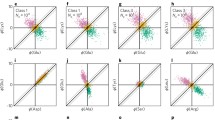Abstract
CLARKE1 says that his observations “invalidate” several “less critical” studies, in which category he places one by us2. Clarke's calculations are based essentially on two contributions by others; these are the “objective classification of the chemical properties of the amino-acids” by Sneath3 and two tables in Dayhoff's Atlas4. We believe that classification procedures for amino-acids should be used with caution. Indeed, Clarke quotes a remark by Zuckerkandl and Pauling5 that “apparently chemists and protein molecules do not share the same opinions regarding the definition of the most prominent properties of a residue”. There is much point to this remark. In the few large families of homologous proteins that have been studied (haemoglobins, cytochromes and immunoglobulins), many sites are occupied by six or more different amino-acids2. This implies, as is well known, that a great deal of interchangeability is possible at such sites. The flexibility of interchange may reflect a lack of close proximity to other residues in the tertiary structure of the protein.
Similar content being viewed by others
References
Clarke, B., Nature, 228, 160 (1970).
King, J. L., and Jukes, T. H., Science, 164, 788 (1969).
Sneath, P. H. A., J. Theoret. Biol., 12, 157 (1966).
Dayhoff, M. O., Atlas of Protein Sequence and Structure (National Biomedical Research Foundation, Silver Spring, 1969).
Zuckerkandl, E., and Pauling, L., in Evolving Genes and Proteins (edit. by Bryson, V., and Vogel, H. J.) (Academic Press, New York, 1965).
Ingram, V. M., The Haemoglobins in Genetics and Evolution, 165 (Columbia University Press, 1963).
Kimura, M., and Ohta, T., Nature, 229, 467 (1971); Ohta, T., and Kimura, M., J. Mol. Evol. (in the press).
Author information
Authors and Affiliations
Rights and permissions
About this article
Cite this article
JUKES, T., KING, J. Deleterious Mutations and Neutral Substitutions. Nature 231, 114–115 (1971). https://doi.org/10.1038/231114a0
Received:
Issue Date:
DOI: https://doi.org/10.1038/231114a0
- Springer Nature Limited
This article is cited by
-
Toxicity of pyrrolizidine alkaloids to humans and ruminants
Phytochemistry Reviews (2011)
-
Mutational dynamics and phylogenetic utility of noncoding chloroplast DNA
Plant Systematics and Evolution (2009)
-
An Analysis of Unclassified Missense Substitutions in Human BRCA1
Familial Cancer (2006)
-
Evolution of protein inhibitors of serine proteinases: Positive Darwinian selection or compositional effects?
Journal of Molecular Evolution (1988)
-
Amino acid composition and the evolutionary rates of protein-coding genes
Journal of Molecular Evolution (1985)





